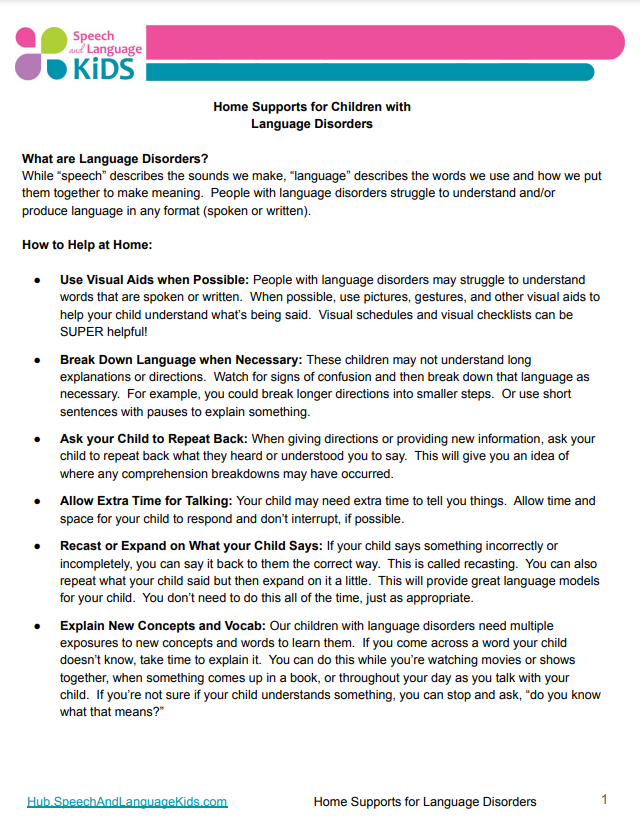How to Help a Child with a Language Delay at Home
While “speech” describes the sounds we make, “language” describes the words we use and how we put them together to make meaning. People with language disorders struggle to understand and/or produce language in any format (spoken or written). We can help children with language delays by providing them with supports that help them be more successful in their communication. We can also modify the environment slightly to support their language needs. Here are some great ways to do that:
Are you looking for how to help a late talker or language-delayed young child? This article will give some ideas on how you can help promote great language development in your own home.
Home Supports for Language Delay 1:
Don’t Anticipate Your Child’s Needs
If you’re reading this blog then I know you care about your child and you are a wonderful parent/caregiver. And as a wonderful parent/caregiver, you probably have a pretty good sense of what your child wants or needs when he starts pointing, grunting, whining, crying, or using any other form of non-verbal communication. Or, you may even know before the child indicates the need. When I say, “don’t anticipate your child’s needs”, I mean wait and see if your child will tell you what he needs. Instead of reaching up and getting the toy off the shelf that your child is looking at, wait and see if he asks for it. If he uses non-verbal communication (such as crying or pointing), prompt him by saying “what do you want?” If your child is not yet using spoken words to communicate what he wants or needs, you can try using some sign language.
Home Supports for Language Delay 2:
Try Using Sign Language with Late Talkers or Non-Verbal Children
Using sign language with children who are not talking yet can serve as a bridge to spoken communication. It teaches children the power of communication. For many of these children, they have yet to see that they can get things they want just by communicating. By helping children use signs for things that they want, you can show them how powerful communication can be and they will be more motivated to communicate verbally when they find out they can control their environment by doing so. I will be creating a new blog post here soon that will go into more detail about sign language and how it can be used to help children with language delay (including a video of some common signs) so check back in with me soon. For now, just keep in mind that you can use any signs you want, as long as they are consistent for your family and your child. You can use American Sign Language (ASL) signs, or you can use “baby sign” which is a modified collection of ASL signs made easier for small children.
Check out these sign language flash cards with common first words
Home Supports for Language Delay 3:
Break Down Directions into Smaller Steps
Children with language delays have trouble understanding long directions. In fact, the fewer words you can use when giving directions to your child, the better. If you need your child to do something, see if you can break that direction down into the smallest possible utterance. For example:
- Instead of: “Sweetie, could you please go up to your bedroom and get your pink shoes for Mommy?”
- Say this: “Ellie, get shoes”
- Instead of “Bobbie, can you find a place to sit at the dinner table? It’s time to eat”
- Say this: “Bobbie, sit down”
It may sound harsh taking out all that fluff but trust me, if your child has a language delay, this will help her tremendously! You can also break down multi-step directions by giving your child one step at a time. For example, if you need your child to put on her shoes, get her backpack, and meet you by the door, you may want to start with just “put on shoes”. You may have to help your child with these directions at first until she understands. Then, once she can do simple one-step directions on her own, increase the challenge and start putting two very simple steps together, such as “First get shoes, then get backpack”.
Home Supports for Language Delay 4:
Speak To Your Child Using Shorter Utterances
Generally speaking, when speaking with your child you should try to use sentences that are at or slightly above the level of sentences that he is using. For example, if your child is only using one word at a time, then when you speak to him, you should use a lot of one-word utterances (to label, show, play, etc) but also include a lot of two-word utterances. The reason for this is that chances are if your child can only produce one or two-word utterances, he probably can’t understand utterances that are much longer than this. Also, this provides him a model for how to increase his utterances to the next level. As in the example above, if you are using a lot of two-word utterances, he will begin to understand how he can put two words together. You don’t have to do this all the time, but during your language-building times, this will really help your child. Just keep in mind that if you say something to your child in a sentence that is much longer and more complex than those he is using, he probably won’t understand most of it.
Home Supports for Language Delay 5:
Build On Your Child’s Utterances
When you are playing with your child, you can repeat their utterances and then add something to them. It’s usually best to just add one or two words. Here are some examples of how you can build on your child’s utterances:
- Child: “Train!”
- Ways to build on this utterance “Train!”, “Train Go!”, “Blue train”, “My train”, “That’s a train”
- Child: “Throw Ball”
- Ways to build on this utterance: “Throw ball”, “Mommy throw ball”, “Throw ball fast”, “Throw yellow ball”
This is a great way to increase their use of grammatical markers as well, you can repeat back a sentence that your child says but include the pieces they left out that make the sentence grammatically incorrect
- Child: “I go park?”
- Parent: “Yes! I go to the park!
Home Supports for Language Delay 6:
Tell Your Child What Things Are Called
This is one you can do everywhere you go! Many children with language delays have trouble knowing what things are called. You can improve vocabulary skills in your child by labeling things EVERYWHERE! The best way to do this, is to simply show your child something and say what it is. If you do this is one single word, your child won’t get confused by any other words that get in the way. For example, if you hold up a ball, just say “Ball”. Then, if you want to use the word in a simple sentence you can, but make sure your child hears you say just the name of the object/action.
Home Supports for Language Delay 7:
Read With Your Child!
If you keep exploring this sit, you are going to see this one come up A LOT! One of the best things you can do to help your child develop great speech, language, and reading skills is to read with your child. Set aside some time every day to read with your child. The best thing is, you can use all of the above strategies while reading books with your child. You can wait for your child to ask to turn the page, you can show your child the signs for some of the objects in the book, you can give your child short, simple directions like “touch cat”, you can practice using shortened utterances to describe the pictures (like “Cat! Cat sleeps. Goodnight Cat”), you can build a word or two onto whatever utterances your child makes about the book, and you can label objects and actions in the book by saying a single word. HOW FANTASTIC IS THAT? Books are wonderful resources for our children’s development. Make sure you have a variety of books for your child, including fiction and nonfiction books (like a book that tells all about trains, dinosaurs, or your child’s favorite topic).

About the Author: Carrie Clark, MA CCC-SLP
Hi, I’m Carrie! I’m a speech-language pathologist from Columbia, Missouri, USA. I’ve worked with children and teenagers of all ages in schools, preschools, and even my own private practice. I love digging through the research on speech and language topics and breaking it down into step-by-step plans for my followers.
Connect with Me:








Great Tips ! Please share some good book titles which can be used for 4 year old.
I have a boy child who was born prematurely at 6.5months,now he is 6 years old,his speech therapy started at 2 years but he has not shown any development,he utters sylabells while playing but no words,he doesn’t imitate our actions too,he has developmental delays.kindly guide me with the correct approach for my Kid
Hello, Leena!
Thank you so much for reaching out. Unfortunately, we get a ton of questions every day about how to solve specific speech/language problems. Since we have such a small staff, we aren’t able to answer every question that comes through on the website, social media, or via email. If you are a parent, we suggest you reach out to a local speech-language pathologist who can work with your child directly and answer your question.
If you are another speech-language professional, we have created a membership where we pay a full staff to answer questions like this on a regular basis. We would be more than happy to answer your question inside the membership program. We’re able to answer more questions in here because we have a full library of questions that we’ve already answered so our staff can either link you to the answer if it exists, or write you a custom response if needed. We’d love to see you inside the membership!
Click Here to Become a Member: https://www.slpsolution.com/pediatric-signup/.